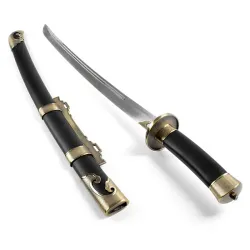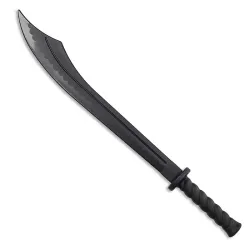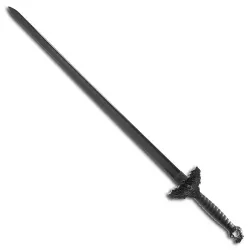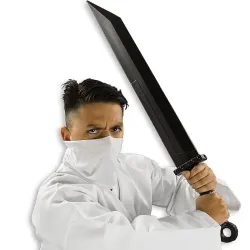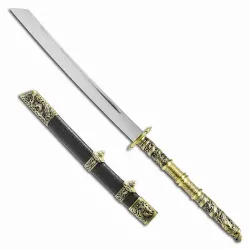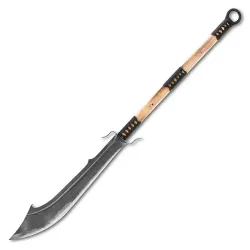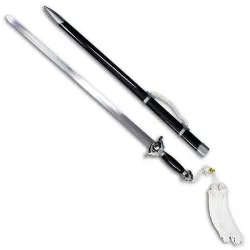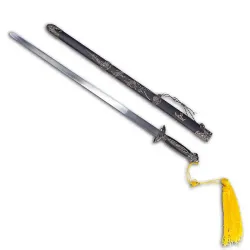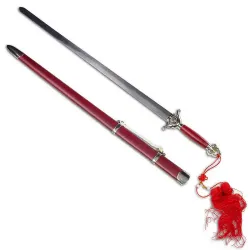Tai Chi, Kung Fu & Chinese Martial Arts Swords
-
$139.95
-
$32.95
-
$219.95
-
$109.95
-
$339.95
-
$99.95
-
$139.95
-
$119.95
-
$39.95
-
$209.95
-
$69.95
-
$64.95
-
$69.95
Let's start with the jian, which is often called the straight sword or Tai Chi sword. This design goes back more than 2,500 years, and some of the earliest bronze versions were used during the Spring and Autumn period in ancient China. Over time, the jian evolved into a slimmer, more refined weapon, usually double-edged, and balanced for both thrusting and slashing. It was often associated with scholars, nobility, and martial artists who practiced internal styles like Tai Chi or Wudang. In fact, the jian became so respected that it earned a nickname: "The Gentleman of Weapons." It was not built for brute force, but more for precision, control, and fluid motion.
Most people today recognize the jian from Tai Chi sword forms. These swords are usually lightweight, with a long, narrow blade and a flexible design that allows for smooth transitions and expressive movements. Some training versions are made of wood or polypropylene, which are safer for beginners and great for learning the mechanics of each form. But traditional metal jians are still used by experienced practitioners who want to feel the real balance and flow of the weapon.
Now on the other end of the spectrum, there's the dao, often called the Chinese broadsword or Kung Fu sword. Unlike the jian, the dao has a single, curved edge and is known for its powerful, sweeping strikes. It's more of a slashing weapon than a thrusting one, and its design makes it ideal for aggressive, circular movements. The dao became especially popular among soldiers during the Ming and Qing dynasties, when mass-produced steel versions were issued to infantry. It was considered the "saber" of Chinese martial arts, because they were tough, practical, and deadly in close quarters.
Modern martial artists still train with the dao, especially in Kung Fu and Wushu schools. There's a kind of rhythm to it, complete with big, bold cuts followed by sharp turns and spins. You'll see a lot of daos with flexible blades designed to produce a "snap" during performances, but more traditional styles prefer a heavier, stiffer version that mimics the real thing.
While most Chinese martial arts schools focus on either the jian or dao, there's also a lesser-known tradition of twin swords. These usually involve two daos or two jians used simultaneously, often in mirrored or alternating movements. It takes serious coordination and control to pull off, so it's not typically taught until a student has already mastered the basics. Twin swords draw a lot of interest in performance demos and competitions.
Every sword in this section has its own purpose. Some are made purely for training, with unsharpened edges and lightweight materials. Others are made for display, featuring ornate designs and decorative hilts. And of course, there are a few that sit somewhere in between, with decent balance and enough durability for light forms practice. Whether you're working through a Tai Chi routine, studying a classic Kung Fu form, or just appreciate the craftsmanship of these weapons, we have an excellent variety of Chinese swords for you to choose from.
What Types of Chinese Swords Are There?
Chinese swords come in a variety of forms, each designed for different styles of training, performance, or display. The two most well-known types are the jian, a straight, double-edged sword, and the dao, a curved, single-edged broadsword. These are the primary weapons used in Chinese martial arts like Tai Chi, Kung Fu, Wudang, and Wushu.
Beyond those, there are also wooden and polypropylene training swords made for beginners or safe practice, along with performance-grade swords built with ultra-flexible blades for speed and flash. Some swords in this section are fully sharpened, others are designed strictly for forms and drills, and some are made for decorative purposes with engraved blades and ornate guards.
While less common, styles like twin swords (usually a matching pair of jians or daos) also exist and are used in advanced forms. Even though they're not widely practiced, they remain an important part of Chinese sword culture and show up in competitions and demos.
What's the Difference Between a Jian and Dao?
The jian and dao are fundamentally different weapons, both in form and in how they're used. The jian has a straight, double-edged blade and is typically used for precise, balanced movements. It's often called the "gentleman of weapons" because of its connection to scholars and internal martial arts like Tai Chi and Wudang. Jian techniques emphasize finesse, redirection, and timing over brute strength.
The dao, on the other hand, is a single-edged broadsword with a curved blade meant for powerful, slashing motions. It became popular in military use during the Ming and Qing dynasties due to its durability and cutting efficiency. In martial arts like Kung Fu and modern Wushu, the dao is used with wide, sweeping movements and spinning techniques that highlight its aggressive nature.
In short, if you're looking for a sword that flows with subtlety and control, the jian is your weapon. If you prefer bold, dynamic strikes and a heavier feel, the dao is a better choice.
What's the Best Sword for Kung Fu Training?
The dao, or Chinese broadsword, is the most commonly used weapon in Kung Fu training. Lightweight daos with flexible blades are popular for modern Wushu routines, while traditional schools often prefer heavier versions with a solid steel blade and thicker spine to simulate real-world use.
How Long Is a Typical Chinese Sword?
Most Chinese swords fall between 28 and 33 inches in blade length. Jian swords used for Tai Chi are often chosen so that the tip reaches the practitioner's ear when held vertically. Dao swords tend to follow similar sizing but may feel longer due to the curve and blade shape.
What's the Difference Between Wushu Swords and Traditional Swords?
Wushu swords are built for performance, using thin, flexible blades that produce a snapping sound during quick movements. They're lightweight and highly responsive, but not designed for cutting or realistic impact. Traditional swords are typically heavier, stiffer, and closer in design to historical weapons used in actual combat or classical martial arts forms.
Why Are Broadswords Called Kung Fu Swords?
The Chinese broadsword, or dao, is commonly referred to as a Kung Fu sword because it's widely used in traditional Kung Fu training. Its curved, single-edged blade is ideal for the sweeping strikes, spins, and slashes seen in external martial arts. Over time, the term "Kung Fu sword" became a general way to describe the dao in both training and pop culture.
Is a Tai Chi Sword the Same as a Jian?
Yes, the Tai Chi sword is typically a jian, which is a straight, double-edged Chinese sword known for its balance and precision. Because the jian is used in most Tai Chi sword forms, the terms are often used interchangeably. However, not all jians are made for Tai Chi; some are heavier or designed for traditional combat styles rather than internal martial arts.

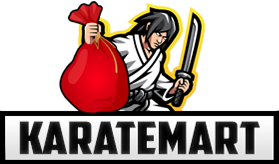



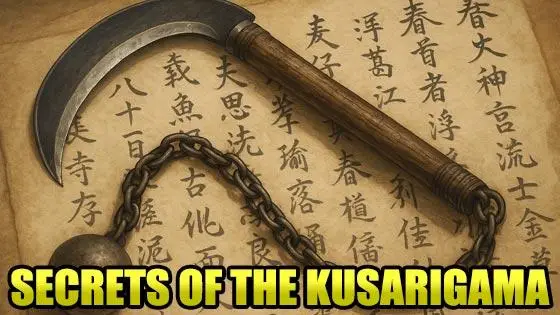

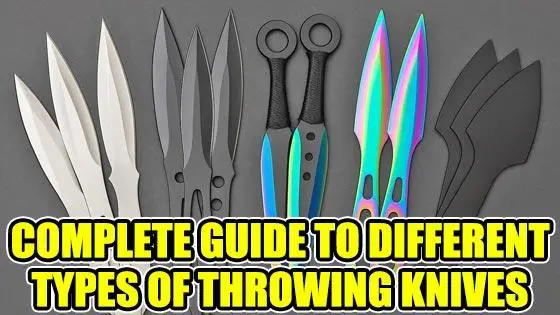

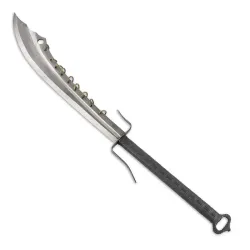

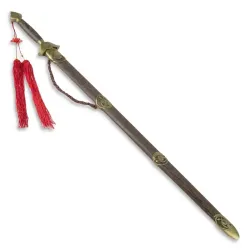


 (1)
(1)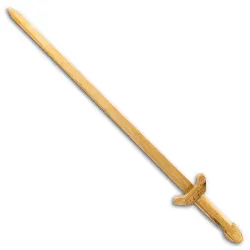
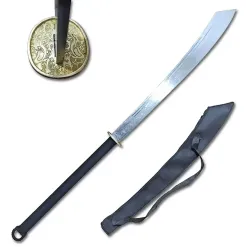



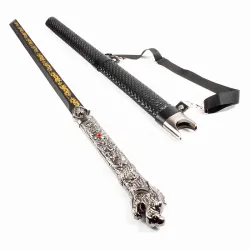
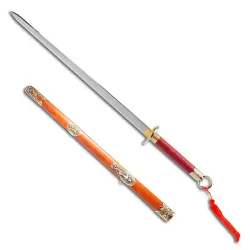
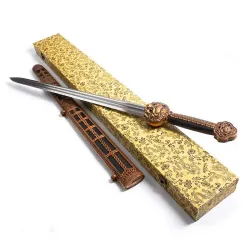
 (1)
(1)